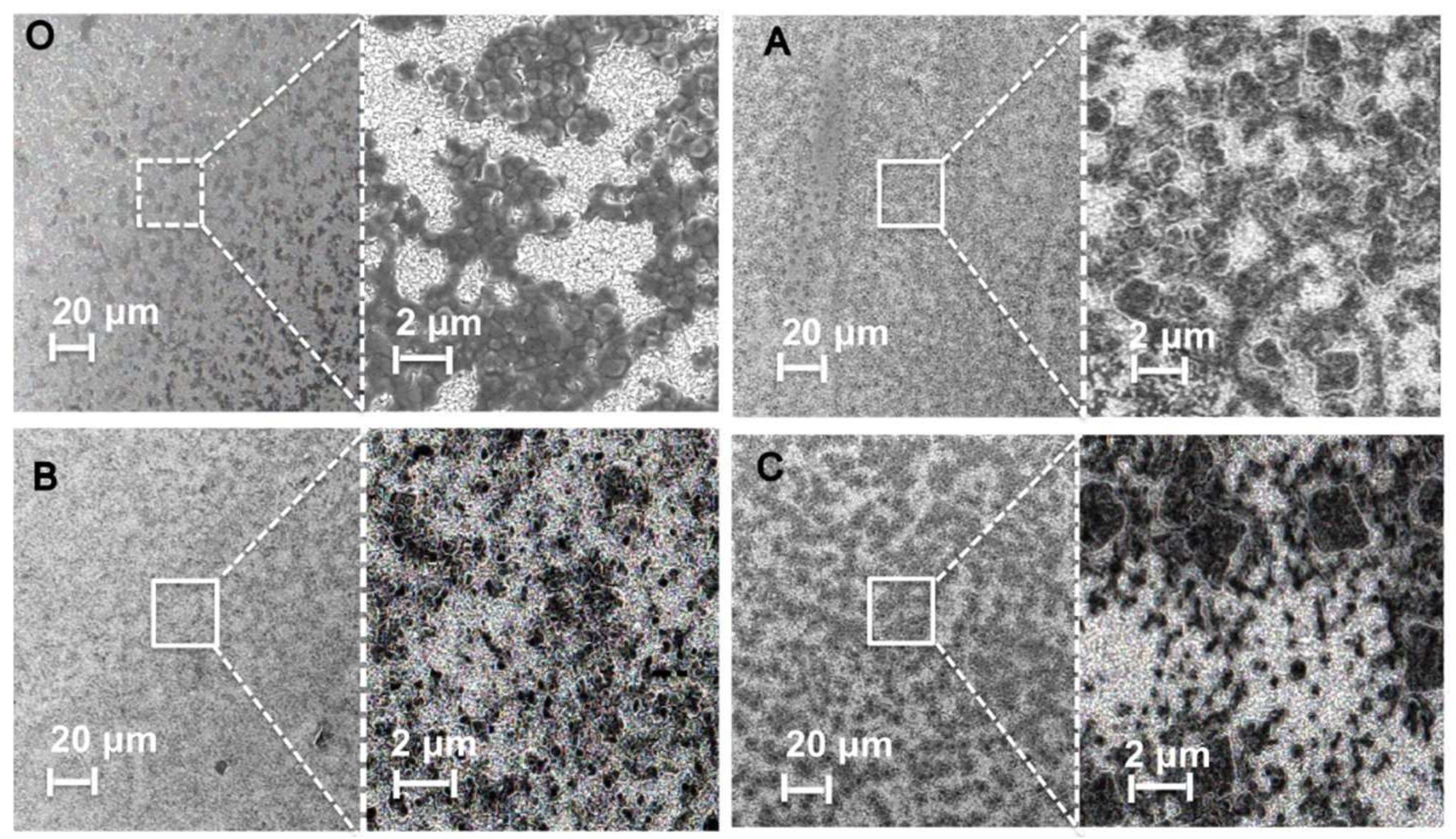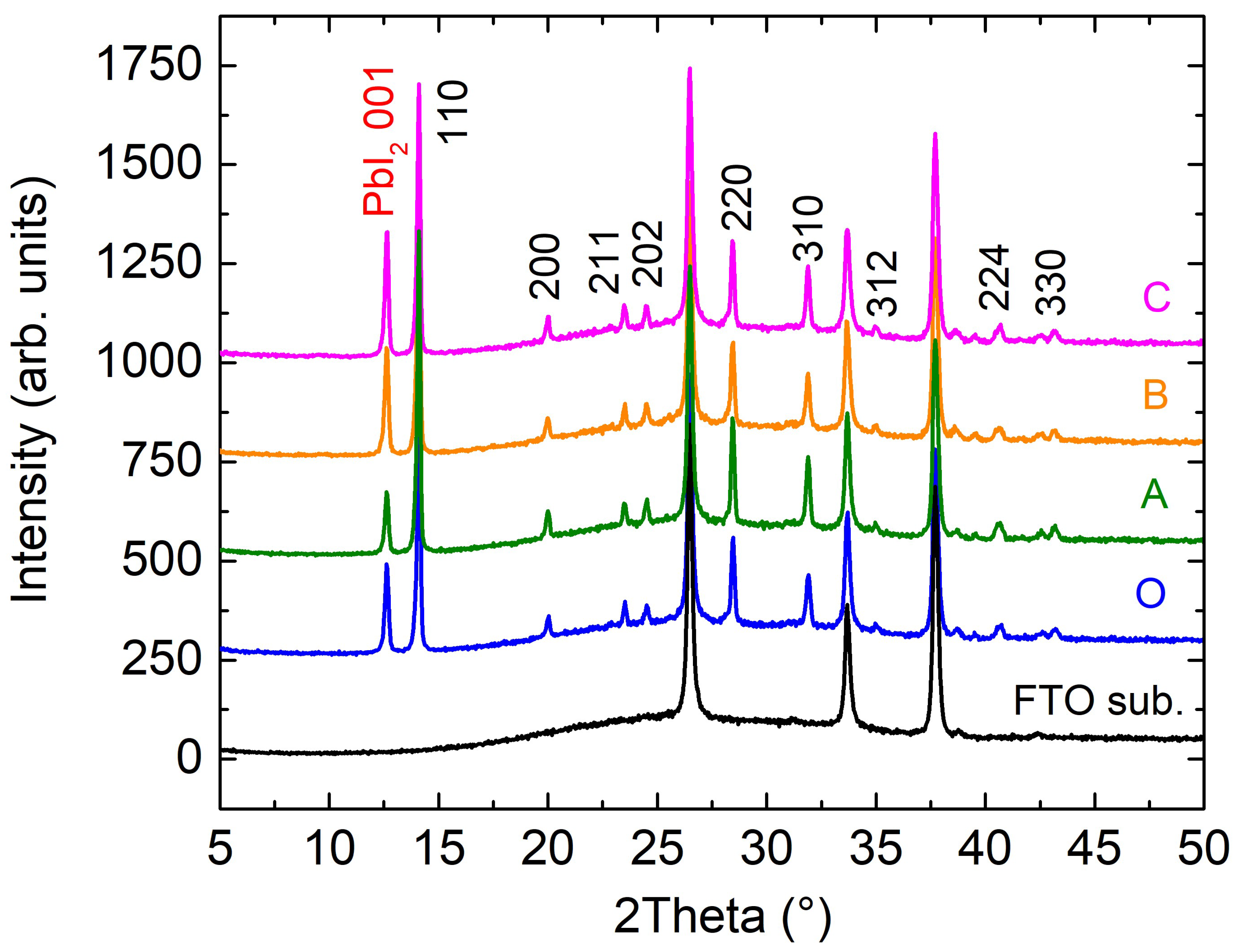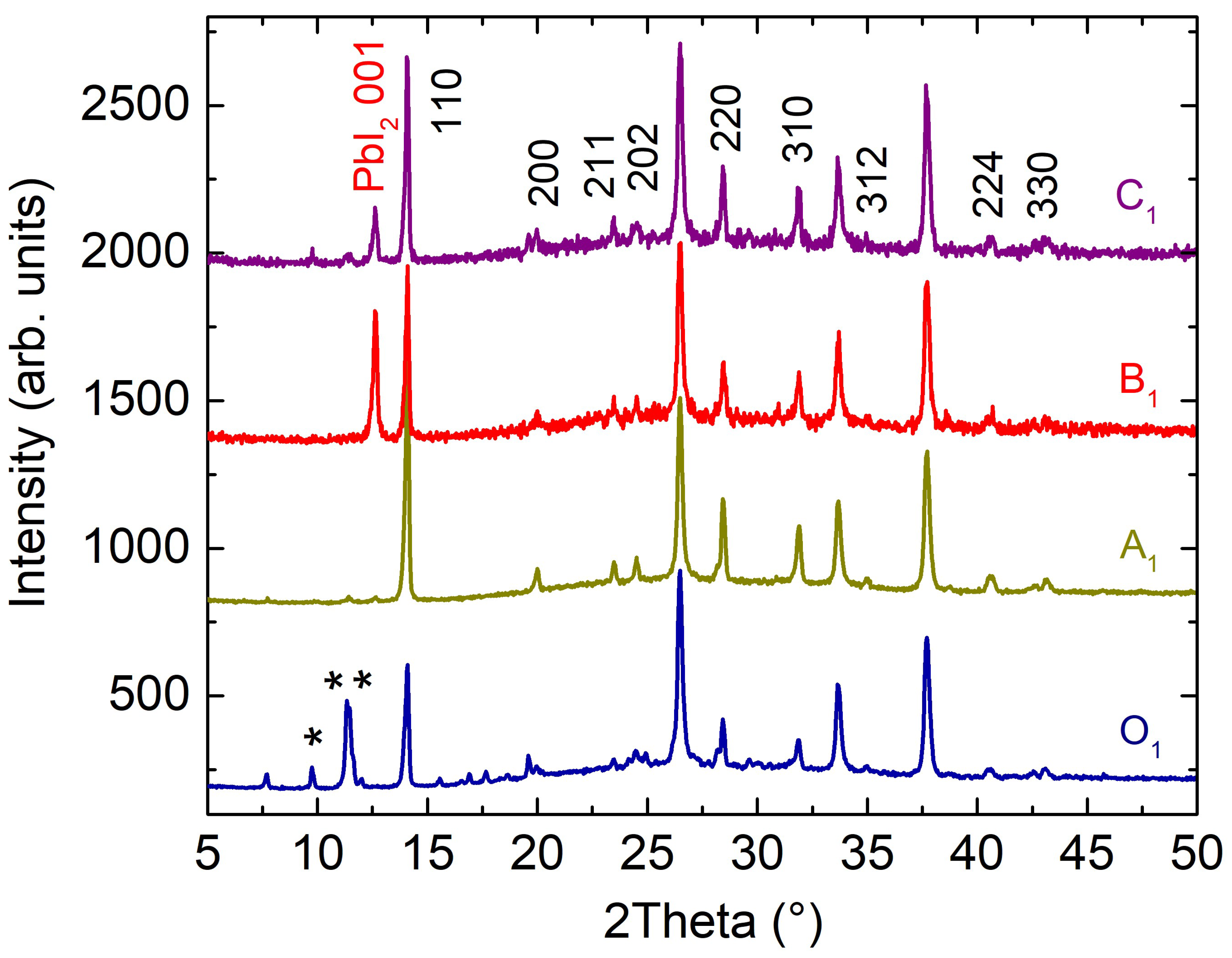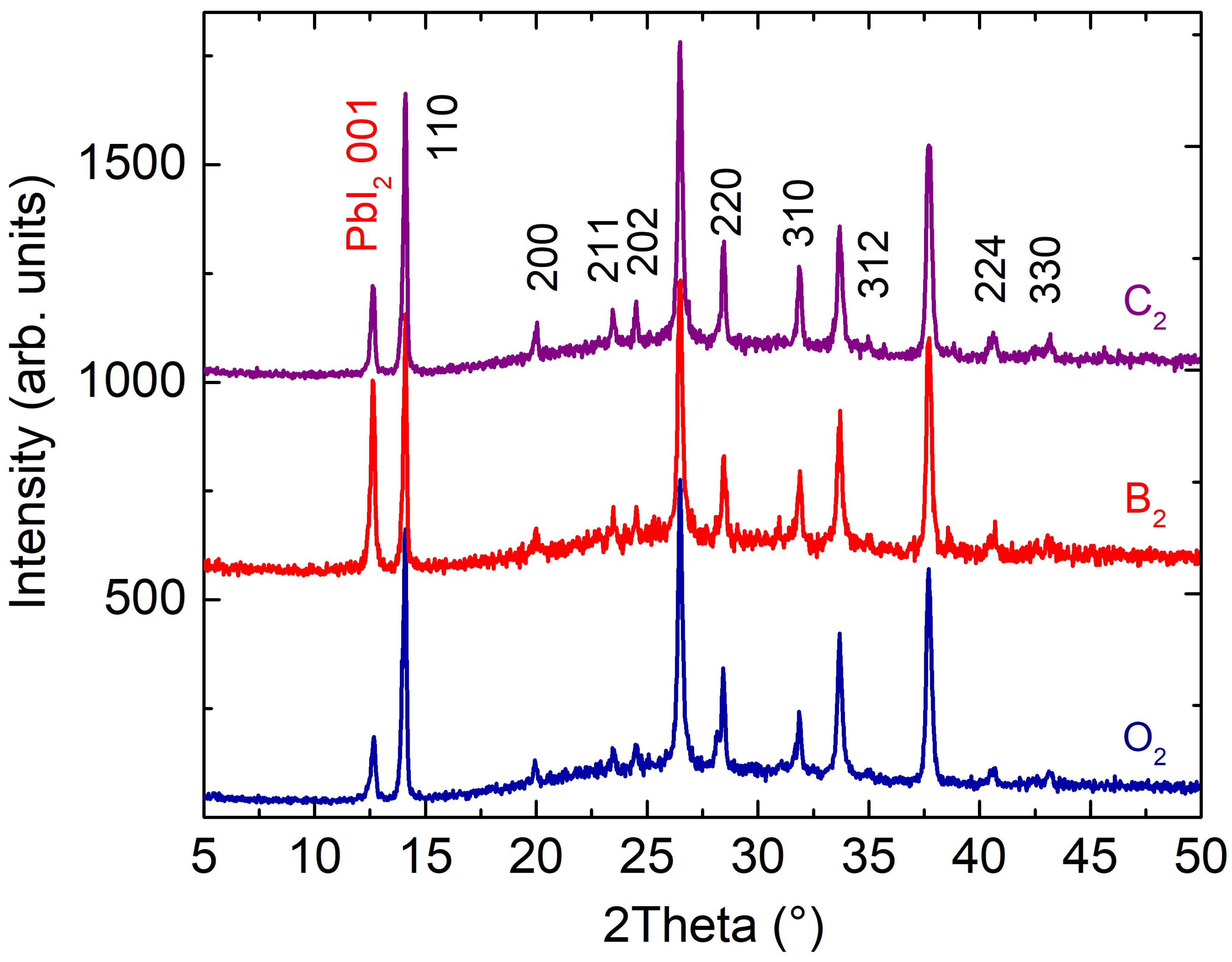Short-Chain Acid Additives to Control PbI2 Crystallization in Hybrid Perovskite Films
Abstract
:1. Introduction
2. Results and Discussion
3. Materials & Methods
3.1. Perovskite Film Preparation
3.2. Adding Selected Acids
3.3. Film Deposition
3.4. Film Characterization
Author Contributions
Funding
Institutional Review Board Statement
Informed Consent Statement
Acknowledgments
Conflicts of Interest
References
- Mathews, N.; Sun, S.; Lim, S.S.; Lam, Y.M.; Gräetzel, M.; Mhaisalkar, S.; Sum, T.C. Long-Range Balanced Electron- and Hole-Transport Lengths G. Xing in Organic-Inorganic CH NH PbI. Science 2013, 342, 344. [Google Scholar]
- Lee, M.M.; Teuscher, J.; Miyasaka, T.; Murakami, T.N.; Snaith, H.J. Efficient Hybrid Solar Cells Based on Meso-Superstructured Organometal Halide Perovskites. Science 2012, 338, 643–647. [Google Scholar] [CrossRef] [Green Version]
- Chen, C.; Li, C.; Li, F.; Wu, F.; Tan, F.; Zhai, Y.; Zhang, W. Efficient perovskite solar cells based on low temperature solution-processed (CH3NH3)PbI3perovskite/CuInS2 planar heterojunctions. Nanoscale Res. Lett. 2014, 9, 457. [Google Scholar] [CrossRef] [PubMed] [Green Version]
- Fan, Z.; Xiao, H.; Wang, Y.; Zhao, Z.; Lin, Z.; Cheng, H.-C.; Lee, S.-J.; Wang, G.; Feng, Z.; Goddard, W.A.; et al. Layer-by-Layer Degradation of Methylammonium Lead Tri-iodide Perovskite Microplates. Joule 2017, 1, 548–562. [Google Scholar] [CrossRef] [Green Version]
- Azpiroz, J.M.; Mosconi, E.; Bisquert, J.; De Angelis, F. Defect Migration in Methylammonium Lead Iodide and Its Role in Perovskite Solar Cell Operation. Energy Environ. Sci. 2015, 8, 2118–2127. [Google Scholar] [CrossRef]
- Huang, P.-H.; Wang, Y.-H.; Ke, J.-C.; Huang, C.-J. The Effect of Solvents on the Performance of CH3NH3PbI3 Perovskite Solar Cells. Energies 2017, 10, 599. [Google Scholar] [CrossRef] [Green Version]
- Fateev, S.A.; Petrov, A.A.; Khrustalev, V.N.; Dorovatovskii, P.V.; Zubavichus, Y.V.; Goodilin, E.A.; Tarasov, A.B. Solution Processing of Methylammonium Lead Iodide Perovskite from γ-Butyrolactone: Crystallization Mediated by Solvation Equilibrium. Chem. Mater. 2018, 30, 5237–5244. [Google Scholar] [CrossRef]
- Im, J.-H.; Lee, C.-R.; Lee, J.-W.; Park, S.-W.; Park, N.-G. 6.5% efficient perovskite quantum-dot-sensitized solar cell. Nanoscale 2011, 3, 4088–4093. [Google Scholar] [CrossRef] [Green Version]
- Niu, G.; Guo, X.; Wang, L. Review of recent progress in chemical stability of perovskite solar cells. J. Mater. Chem. A 2015, 3, 8970. [Google Scholar] [CrossRef]
- Wang, K.; Ecker, B.; Huang, J.; Gao, Y. Evaporation of Methylammonium Iodide in Thermal Deposition of MAPbI3. Nanomaterials 2021, 11, 2532. [Google Scholar] [CrossRef]
- Burschka, J.; Pellet, N.; Moon, S.-J.; Humphry-Baker, R.; Gao, P.; Nazeeruddin, M.K.; Grätzel, M. Sequential deposition as a route to high-performance perovskite-sensitized solar cells. Nature 2013, 499, 316. [Google Scholar] [CrossRef] [PubMed]
- Wu, Y.; Islam, A.; Yang, X.; Qin, C.; Liu, J.; Zhang, K.; Peng, W.; Han, L. Retarding the crystallization of PbI2for highly reproducible planar-structured perovskite solar cells via sequential deposition. Energy Environ. Sci. 2014, 7, 2934–2938. [Google Scholar] [CrossRef]
- Jeon, N.J.; Noh, J.H.; Kim, Y.C.; Yang, W.S.; Ryu, S.; Seok, S.I. Solvent engineering for high-performance inorganic–organic hybrid perovskite solar cells. Nat. Mater. 2014, 13, 897–903. [Google Scholar] [CrossRef] [PubMed]
- Chen, Q.; Zhou, H.; Hong, Z.; Luo, S.; Duan, H.-S.; Wang, H.-H.; Liu, Y.; Li, G.; Yang, Y. Planar Heterojunction Perovskite Solar Cells via Vapor-Assisted Solution Process. J. Am. Chem. Soc. 2014, 136, 622–625. [Google Scholar] [CrossRef] [PubMed]
- Klein, E.; Heymann, L.; Hungria, A.B.; Lesyuka, R.; Klinke, C. Colloidal lead iodide nanorings. Nanoscale 2018, 10, 21197–21208. [Google Scholar] [CrossRef] [Green Version]
- Klein, E.; Lesyuk, R.; Klinke, C. Insights into the formation mechanism of two-dimensional lead halide nanostructures. Nanoscale 2018, 10, 4442. [Google Scholar] [CrossRef] [Green Version]
- Hsiao, C.-P.; Siebert, K.J. Modelling the inhibitory effects of organic acids on bacteria. Int. J. Food Microbiol. 1999, 47, 189–201. [Google Scholar] [CrossRef]
- Bala, T.; Prasad, B.L.V.; Sastry, M.; Kahaly, M.U.; Waghmare, U.V. Interaction of Different Metal Ions with Carboxylic Acid Group: A Quantitative Study. J. Phys. Chem. A 2007, 111, 6183–6190. [Google Scholar] [CrossRef]
- Gupta, R.K.; Garai, R.; Iyer, P.K. Ambient St Perovskite Solar Cells through Trifluoro Acetic Acid-Mediated Multifunctional Anchoring. ACS Appl. Energy Mater. 2022, 5, 1571–1579. [Google Scholar] [CrossRef]
- Zhu, H.; Duan, C.; Qin, M.; Liu, Z.; Li, J.; Yuan, L.; Wen, Q.; Lu, X.; Shi, L.; Xie, J.; et al. Trifluoromethylphenylacetic Acid as In Situ Accelerant of Ostwald Ripening for Stable and Efficient Perovskite Solar Cells. Sol. RRL 2021, 5, 2100040. [Google Scholar] [CrossRef]
- Meng, L.; Wei, Q.; Yang, Z.; Yang, D.; Feng, J.; Ren, X.; Liu, Y.; Liu, S. (Frank). Improved perovskite solar cell efficiency by tuning the colloidal size and free ion concentration in precursor solution using formic acid additive. J. Energy Chem. 2020, 41, 43–51. [Google Scholar] [CrossRef] [Green Version]
- Adil Afroz, M.; Ghimire, N.; Reza, K.M.; Bahrami, B.; Bobba, R.S.; Gurung, A.; Chowdhury, A.H.; Iyer, P.K.; Qiao, Q. Thermal Stability and Performance Enhancement of Perovskite Solar Cells Through Oxalic Acid-Induced Perovskite Formation. ACS Appl. Energy Mater. 2020, 3, 2432–2439. [Google Scholar] [CrossRef]
- Foley, B.J.; Girard, J.; Sorenson, B.A.; Chen, A.Z.; Niezgoda, J.S.; Alpert, M.R.; Harper, A.F.; Smilgies, D.-M.; Clancy, P.; Saidie, W.A.; et al. Controlling nucleation, growth, and orientation of metal halide perovskite thin films with rationally selected additives. J. Mater. Chem. A 2017, 5, 113. [Google Scholar] [CrossRef]
- Nayak, P.K.; Moore, D.T.; Wenger, B.; Nayak, S.; Haghighirad, A.A.; Fineberg, A.; Noel, N.K.; Reid, O.G.; Rumbles, G.; Kukura, P.; et al. Mechanism for rapid growth of organic–inorganic halide perovskite crystals. Nat. Commun. 2016, 7, 13303. [Google Scholar] [CrossRef] [PubMed]




| Acid Name | Structure | Film Name | Molar Mass (g/mol) | Boiling Temperature(°C) | Density (g/cm3) | pKa * | Added Acid (μL) |
|---|---|---|---|---|---|---|---|
| NO-ACID | O | # | # | # | # | 0 | |
| Acetic |  | A | 60 | 118 | 1.05 | 4.74 | 7.5 |
| Formic |  | B | 46 | 100.8 | 1.22 | 3.75 | 4.7 |
| Trifluoroacetic |  | C | 114 | 72.4 | 1.49 | −0.25 | 10.0 |
| Film | PbI2 100 Area (arb. Units) | MAPI 110 Area (arb. Units) | PbI2 100/MAPI 110 (%) |
|---|---|---|---|
| O | 42 | 112 | 38 |
| A | 29 | 135 | 21 |
| B | 53 | 118 | 45 |
| C | 59 | 112 | 53 |
| O1 | - | 90 | 0 |
| A1 | - | 157 | 0 |
| B1 | 87 | 100 | 87 |
| C1 | 34 | 122 | 28 |
| O2 | 31 | 128 | 24 |
| B2 | 90 | 101 | 89 |
| C2 | 42 | 120 | 35 |
Publisher’s Note: MDPI stays neutral with regard to jurisdictional claims in published maps and institutional affiliations. |
© 2022 by the authors. Licensee MDPI, Basel, Switzerland. This article is an open access article distributed under the terms and conditions of the Creative Commons Attribution (CC BY) license (https://creativecommons.org/licenses/by/4.0/).
Share and Cite
Dionigi, C.; Calabrese, G.; Ruani, G.; Milita, S. Short-Chain Acid Additives to Control PbI2 Crystallization in Hybrid Perovskite Films. Inorganics 2022, 10, 114. https://doi.org/10.3390/inorganics10080114
Dionigi C, Calabrese G, Ruani G, Milita S. Short-Chain Acid Additives to Control PbI2 Crystallization in Hybrid Perovskite Films. Inorganics. 2022; 10(8):114. https://doi.org/10.3390/inorganics10080114
Chicago/Turabian StyleDionigi, Chiara, Gabriele Calabrese, Giampiero Ruani, and Silvia Milita. 2022. "Short-Chain Acid Additives to Control PbI2 Crystallization in Hybrid Perovskite Films" Inorganics 10, no. 8: 114. https://doi.org/10.3390/inorganics10080114
APA StyleDionigi, C., Calabrese, G., Ruani, G., & Milita, S. (2022). Short-Chain Acid Additives to Control PbI2 Crystallization in Hybrid Perovskite Films. Inorganics, 10(8), 114. https://doi.org/10.3390/inorganics10080114







